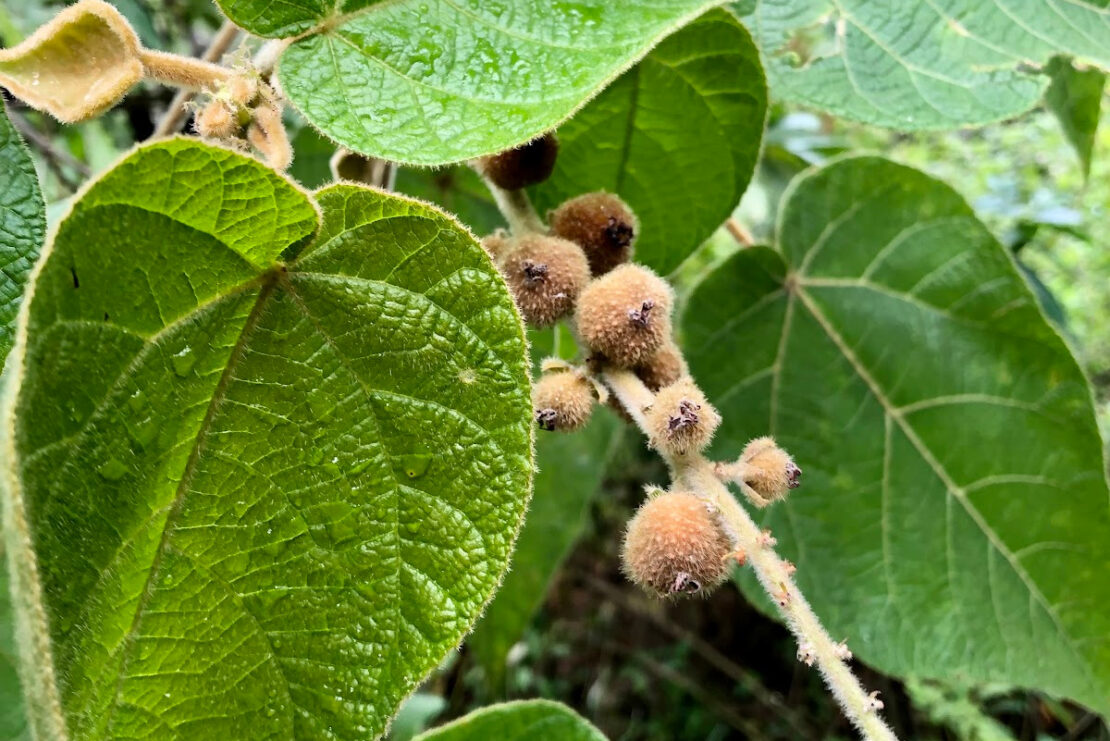
Andean Plants and Their Herbal Uses
The Andes mountains are home to at least 20,000 endemic species of Andean plants (Myers et al., 2000 as cited by Cueva-Agila et al., 2019). In Ecuador, the Eastern Cordillera Real montane forests ecoregion boasts up to 8,000 different plant species (Richter et al., 2009). The southern part of the country, especially the Loja and Zamora-Chinchipe provinces, is particularly biodiverse (Brehm et al., 2008). This is due to many different microclimates that are formed by widely varying topography that includes valleys, high mountains, and the inter-Andean region, also known as the Sierra (Richter, 2003 as cited by Cueva-Agila et al., 2019).
Where I live in Southern Ecuador (in Loja province), in the corner of an eco-sanctuary at the edge of Podocarpus National Park, there is an incredible variety of useful plants. A few of my favorites are matico (Piper aduncum), calaguala (Polypodium leucotomos), sangre del drago (Croton lechleri), and cascarilla (Cinchona officinalis and C. pubescens). These are some of the most popular plants native to this region that are a cherished part of the local pharmacopeia.
Andean Plants and Their Herbal Uses
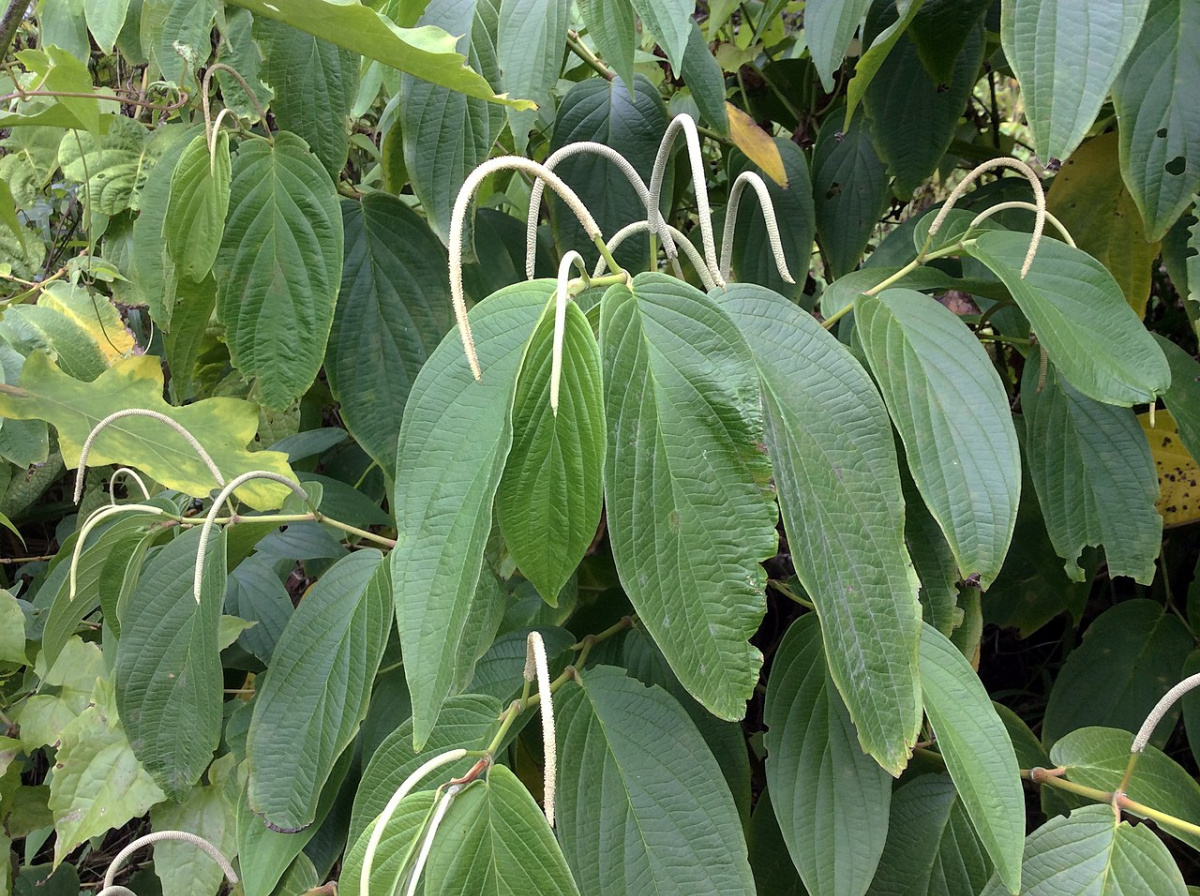
Piper aduncum (https://commons.wikimedia.org/wiki/File:Piper_aduncum.jpg) by João Medeiros, CC BY 2.0 (https://creativecommons.org/licenses/by/2.0)
Matico (Piper aduncum)
Piper aduncum, commonly known as matico, is a member of the Piperaceae (pepper) family, which contains around 3,600 species that grow widely throughout the subtropical and tropical regions of the world (Encyclopaedia Britannica, 2018). One of the more well-known plants in this family is Piper nigrum, which produces the spice black pepper. Many herb lovers in North America will also be familiar with Piper methysticum, or kava kava. Piper aduncum is native to Central and South America. It is a fairly small, shrubby tree with slender, oval-shaped leaves and knobby branches. The whole plant is aromatic, with a distinct peppery smell. The flowers form on drooping whitish spikes. I often find matico growing wild near mountain creeks and streams near our home.
Matico has long been used by traditional healers for wounds, kidney disorders, diarrhea, stomach pain, ulcers, rheumatism, boils, and skin infections; the tea has been used to ease menstrual cramps, to stop hemorrhaging, and as an overall health tonic (De La Torre et al., 2008). In Ecuador, it is most commonly used to promote the healing of cuts, insect bites, inflamed skin, and abrasions. An infusion of the leaves is often used as a wash for wounds, but the crushed fresh leaves or leaf powder can also be applied topically.
Modern research supports these traditional uses. Multiple studies have found that matico has antibacterial properties (Okunade et al., 1998), including antimicrobial effect of matico essential oil on Staphylococcus epidermis, S. aureus, and Pseudomonas aeruginosa, which contribute to wound infection (Taher et al., 2020).
In Ecuadorian and Peruvian folk medicine, matico is drunk in a tea for cases of diarrhea. Its antimicrobial and astringent properties make it well-suited for this use. Modern research has also found that the essential oil of P. aduncum diluted and used topically improves diarrhea caused by Escherichia coli (Taher et al., 2020).
Several studies have demonstrated the antifungal properties of various matico extractions, typically of the leaf (Guerrini et al., 2009; Hastuti et al., 2017; Navickiene et al., 2006; Okunade et al., 1998; Santos et al., 2013).
Matico is an abundant plant with no sustainability concerns, and is in fact, considered invasive in some places. All the more reason to utilize its beneficial properties as an alternative to at-risk herbs.
On our homestead, we most often use matico as a wash for soothing irritated skin and wounds. We’ve given our horse sponge baths with it when he’s suffered from scrapes, gashes, and itchy skin due to external parasites. I also enjoy making a strong infusion and putting it into a spray bottle once it has cooled so that it can be spritzed onto bug bites, boils, and rashes or used as an aromatic facial toner. Matico is also a wonderful addition to salves, and many local herbalists add it to creams and ointments. I like infusing it into botanical body soaps, as well.
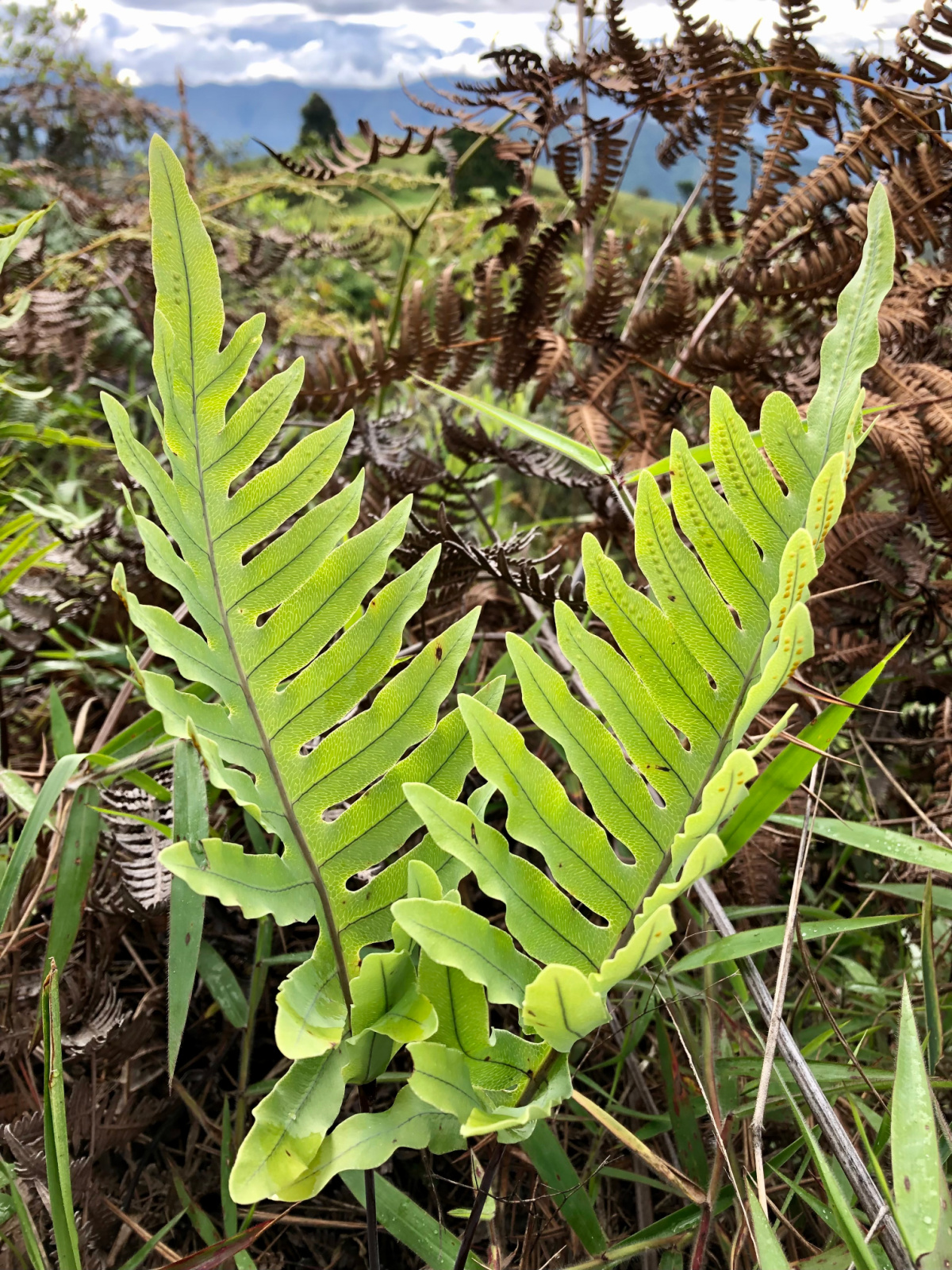
Calaguala (Phlebodium aureum, syn. Polypodium leucotomos)
Calaguala (pronounced “kallawalla”) is another important plant in the Southern region of Ecuador. Polypodium leucotomos (the widely used binomial that is a synonym of its current accepted binomial) is a tropical fern in the Polypodiaceae family. The leaves and rhizomes are utilized for their healing properties.
In South America, poultices of calaguala are used to ease eczema and psoriasis (Winkelmann et al., 2015). Modern Ecuadorian folk use includes boiling the root to make a tea that is drunk to benefit the kidneys or infusing it into vinegar for use as a tonic.
Commercialized extracts of P. leucotomos are available, including Fernblock®, an aqueous extraction of the leaves used for its photoprotective properties. Human clinical studies showed that an extract from the plant lessens the negative effects of UV radiation exposure (Kohli et al., 2017; Nestor, 2015); in vivo and in vitro studies concluded it actually helps to stop UV-induced cell death (Gonzalez et al., 2007).
In their study, Parrado et al. (2020) concluded that P. leucotomos’ photoprotective properties are well demonstrated in multiple studies including human clinical trials, and are supported by its antioxidant, anti-inflammatory, and immune-boosting effects. In a review of multiple studies conducted on extracts of this plant, Berman et al. (2016) concluded there are several different mechanisms for their photoprotective qualities, including decreasing oxidative stress and DNA damage, stopping immunosuppression induced by UV radiation, and inhibiting the inflammatory response triggered by UV exposure. The photoprotective qualities of oral P. leucotomos extract may be particularly useful for individuals who are resistant to applying topical sunscreens (Berman et al., 2016).
P. leucotomos also slows premature skin aging that is caused by prolonged and repeated sun exposure. Its anti-inflammatory and antioxidant properties protect skin cells from being damaged by UV light, which can reduce wrinkles, fine lines, and leathery skin (Pourang et al., 2021).
In Ecuador, the rhizome of calaguala is available for sale at most traditional markets, and it is well-known as being beneficial for skin conditions. I have infused calaguala root into creams for dry, itchy, and rashy skin. Commercially, P. leucotomos is available in capsule form as a dietary supplement and is added to sunscreens.
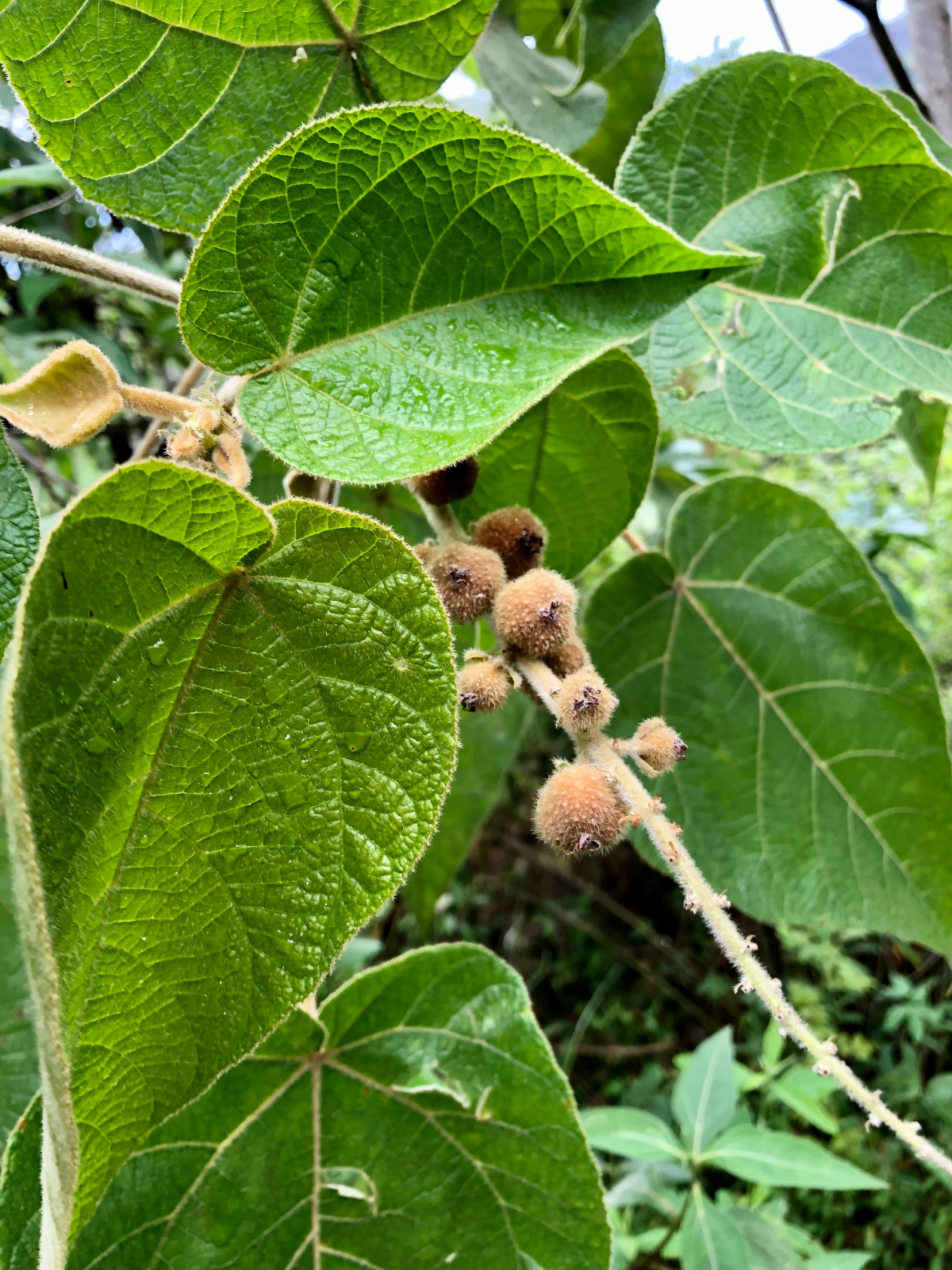
Sangre del drago (Croton lechleri)
Croton lechleri is a tree in the Euphorbiaceae (spurge) family that is native to northwestern South America. Commonly known as Sangre del drago in Ecuador, it is also known as dragon’s blood, or sangre del grado in Peru. It is a medium-sized tree with heart-shaped leaves that grows in the Andes, particularly in Ecuador, Peru, Bolivia, and Colombia. When cut, the bark exudes a red sap that is cherished for its medicinal qualities.
There are around 800 species in the Croton genus, distributed from southern Mexico and Central America to South America; the Andes have a large diversity of Croton species, many of which have useful properties (Coy Barrera et al., 2016).
The name, sangre del drago, is also used to describe several other Croton species, including C. salutaris and C. palanostigma, all of which have the characteristically red sap and can be used interchangeably (PFAF Plant Database, n.d.b).
C. lechleri has long been utilized in folk herbalism for several ailments including wounds, chronic diarrhea, gastritis, ulcers, influenza, tonsillitis, burns, gingivitis, tonsillitis, rheumatism, and more (Coy Barrera et al., 2016; Namjoyan et al., 2016; Ramirez, 2003). It has also been used in childbirth—as a vaginal bath before and after birth and to stop hemorrhaging postpartum (Taylor, 2005).
The red sap has been widely used by the Indigenous people of Ecuador and Peru to soothe wounds and ulcers. The sap is painted directly onto wounds to stop bleeding, improve healing times, and to create a protective barrier to help seal the wound and fend off infection; it can be used on cuts, scrapes, insect bites and stings, and other skin conditions (Taylor, 2005). It should be noted that the sap will temporarily turn the skin a brownish-red color and can permanently stain clothing.
Studies have found that sangre del drago has immunomodulating, anti-inflammatory, and antioxidant properties (Namjoyan et al., 2016) as well as antimicrobial, antifungal, antiviral properties (Pona et al., 2019) and antibacterial properties (Chen et al.,1994; Corrales Ramírez et al., 2013; Gallardo Vásquez & Mejía, 2015). A randomized, double-blind, placebo-controlled clinical trial conducted on 60 patients who had undergone skin tag removal showed that dragon’s blood cream (made with 15% ethanolic extract of C. lechleri) significantly improved the healing time of wounds throughout the healing process; on day 14, the wounds of the individuals in the therapeutic group were 95.73% healed compared to 78.10% in the placebo group (Namjoyan et al., 2016). Further studies have shown that sangre del drago promotes scar formation and boosts the production of collagen, helping to rapidly regenerate the skin (Pona et al., 2019).
A clinical trial found that sangre del drago balm significantly improved itching, swelling, pain, and redness of fire ant bites participants suffered during the study; fire ant bites are known to cause pain and intense itchiness that can persist for weeks (Jones, 2003).
Furthermore, more than 90% of participants receiving a dose of 250 mg twice daily in a clinical trial evaluating the efficacy of sangre del drago for traveler’s diarrhea showed partial or complete improvement of symptoms (including malaise, fever, nausea, bloating, cramps, and urgency) within the first 24 hours (Jones, 2003). The sap has low toxicity and the preparations utilized in clinical trials were generally well tolerated by participants (Jones, 2003); large internal doses should be avoided (Ramirez, 2003).The sap has low toxicity and the preparations utilized in clinical trials were generally well tolerated by participants (Jones, 2003); large internal doses should be avoided (Ramirez, 2003).
The sap of sangre del drago has been used traditionally for infected gums. The Quichua people living in Eastern Ecuador will use a piece of cotton soaked in sap to help alleviate tooth pain due to extractions and cavities (Jones, 2003).
Sangre del drago is readily available for sale here in Ecuador from street and market vendors who sell small dropper bottles of the red sap. It is best to purchase from a source that you know has been sustainably collected to ensure that care has been taken to facilitate the regeneration of harvested areas. Sangre del drago is not currently considered endangered or threatened, and mindful harvesting practices are essential to ensure it stays that way. There are Indigenous communities in the Peruvian and Ecuadorian Amazon who work to harvest the latex with the most efficient methods and are also actively reforesting to ensure the longevity of the species (King, 2020).
Sangre del drago sap is widely recommended for topical use on wounds and insect bites and I have heard local mothers advocate taking it internally for diarrhea, as well. I personally utilize it most often for its wonderful wound mending properties. I apply it topically on cuts, scrapes, insect bites, and so on, and have used it on my dogs and rabbits as well, with great results. We always keep a little dropper bottle full of the red sap on our medicine shelf.

Cascarilla (Cinchona officinalis & C. pubescens)
Cinchona is a tree in the Rubiaceae (coffee) (coffee) family, that is found in western South America. It is most commonly known for its alkaloid, quinine, which is extracted from its bark (Bown,1995 as cited in PFAF Plant Database, n.d.a).
Cinchona species are widely distributed throughout the central and northern Andes, with a noticeable concentration of diverse species in Southern Ecuador. However, due to incredible historic exploitation, many of these species had nearly disappeared in their native ranges. Cinchona species were introduced to other tropical regions for the production of quinine. They have been cultivated in India, Indonesia, Africa, Mexico, and some of the Pacific islands (Jäger, 2011). Today, native populations suffer the effects of habitat loss due to deforestation for the systematic conversion of native forests to pastures or pine-eucalyptus plantations (Tapia-Armijos et al. 2015 as cited in Cueva-Agila et al., 2019).
Cascarilla, also sometimes referred to as Loja bark or Peruvian bark, is most well-known for its use in cases of fevers and malaria. The bark is bitter and astringent, and contains various alkaloids, most notably quinine. Barks usually contain about 16% quinine (per overall bark weight), but the percentage can vary (between 6-10%) depending on the type of cinchona species used (Raza et al., 2021).
The bark can be prepared in various ways, including tablets, tinctures, liquid extracts, and powders. In traditional medicine, it has been used internally for malaria, neuralgia, muscle cramps, hemorrhoids, and atrial fibrillation (Bown,1995 as cited in PFAF Plant Database, n.d.a). The liquid extract has been used to counteract drunkenness. Cascarilla bark extracts are also well known as a bitter flavoring agent in tonic water and carbonated beverages.
Whether Indigenous peoples used cascarilla for fevers is unclear; some authors argue that it was utilized before the arrival of the Spanish for fevers and others say local populations were not aware of its properties for fever support (Jäger, 2011). The Spanish first documented cascarilla’s medicinal properties sometime around 1630 and the bark was increasingly utilized for intermittent fevers (what eventually came to be known as malaria), in the latter half of the 17th century (Cueva-Agila et al., 2019). Cinchona bark entered the London Pharmacopoeia as “Cortex Peruvianus” (Peruvian bark) in 1677 (Jäger, 2011). By 1820, scientists had isolated quinine from the bark (Permin et al., 2016).
Caution must be taken when using this herb, as overdose can cause headache, rash, abdominal pain, and damage to the nervous system leading to deafness and blindness (PFAF Plant Database, n.d.a; Raza et al., 2021). Avoid large and too frequent doses.
Though I have a bottle of cascarilla tincture in my apothecary, I most commonly consume cascarilla in the form of a locally made artisanal tonic water, which I enjoy on occasion with a dash of gin. With the wild populations so depleted, I feel it’s best to harvest this potent herb sparingly. A few cascarilla trees are growing in the eco-sanctuary and it is a pleasure to steward them. They are lovely trees, with sweet little tubular pink flowers that are frequently visited by hummingbirds.
In Closing,
Matico (Piper aduncum), calaguala (Polypodium leucotomos), sangre del drago (Croton lechleri), and cascarilla (Cinchona officinalis and C. pubescens) are a few of the many unique plants that grow in the Andes, and are native to the eco-sanctuary I co-steward. These herbs are an important part of the local pharmacopeia and have many traditional uses that are well supported by modern research.
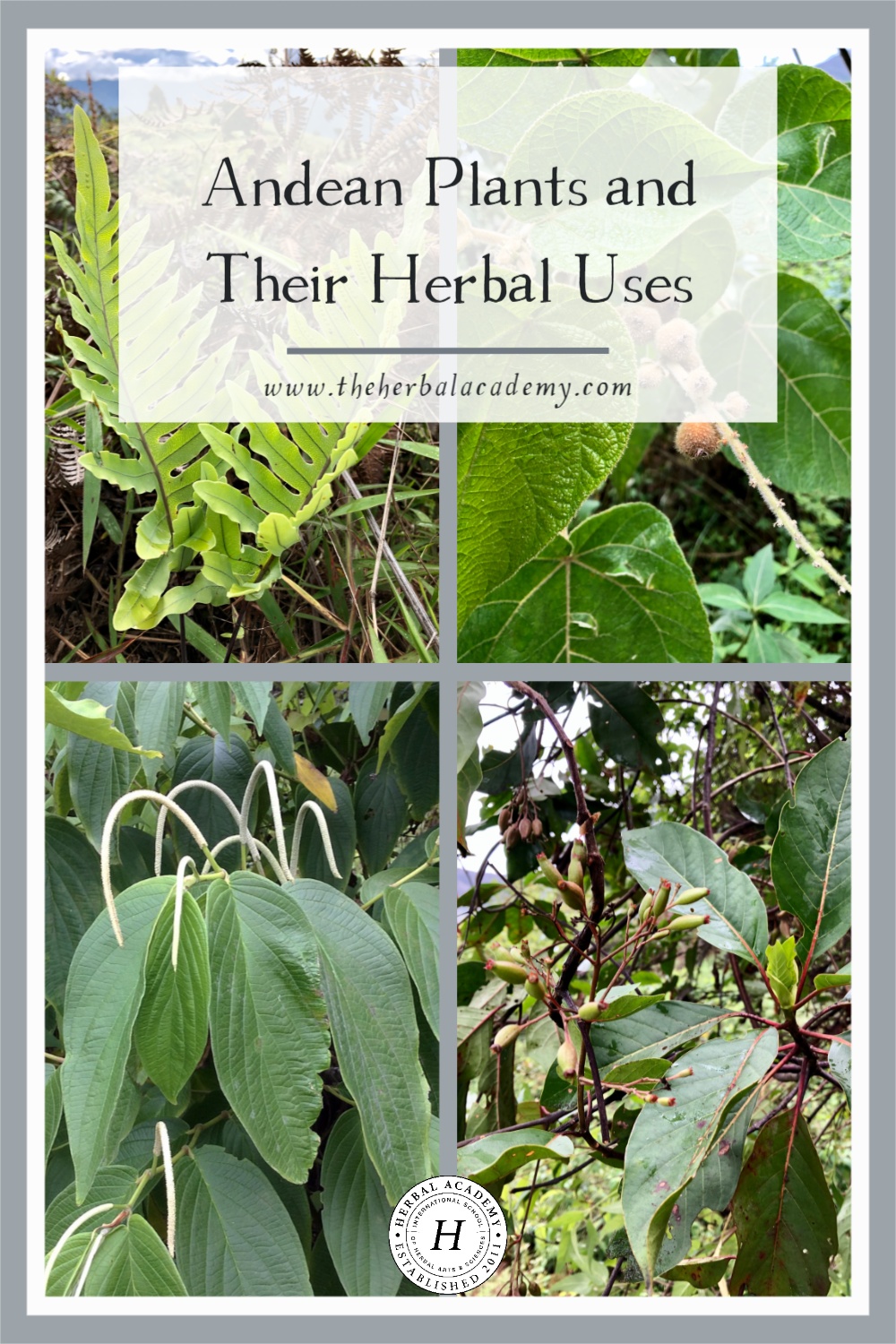
REFERENCES
Berman, B., Ellis, C., & Elmets, C. (2016). Polypodium leucotomos – An overview of basic investigative findings. Journal of Drugs in Dermatology,15(2), 224–228. https://www.ncbi.nlm.nih.gov/pmc/articles/PMC5189711/
Brehm, G., Homeier, J., Fiedler, K., Kottke, I., IIIig, J., Nöske, N.M. … and S.W. Breckle. (2008). (2008) Mountain rain forests in Southern Ecuador as a hotspot of biodiversity – limited knowledge and diverging patterns. In: Beck E., Bendix J., Kottke I., Makeschin F., Mosandl R. (EEds..) Gradients in a Tropical Mountain Ecosystem of Ecuador. Ecological Studies (Analysis and Synthesis), vol 198. Springer, Berlin, Heidelberg. https://doi.org/10.1007/978-3-540-73526-7_2
Chen, Z.P. Cai, Y. & Phillipson, D. (1994). Studies on the aanti-Tumour, anti-bacterial, and wound-healing properties of Dragon’s Blood. Planta Medica, 60(6), 541-545. https://doi.org/10.1055/s-2006-959567
Corrales Ramírez, L., Castillo Castañeda, A., & Melo Vargas, A. (2013). Evaluación del potencial antibacterial in vitro de Croton lechleri frente a aislamientos bacterianos de pacientes con úlceras cutáneas. Nova, 11(19), 51-63. http://www.scielo.org.co/scielo.php?script=sci_arttext&pid=S1794-24702013000100006&lng=en&tlng=es.
Coy Barrera, C.A., Constanza Gómez, D., & Castiblanco, FA. (2016). Importancia medicinal del género Croton (euphorbiaceae). Revista Cubana de Plantas Medicinales, 21(2), 234-247. http://scielo.sld.cu/pdf/pla/v21n2/pla11216.pd
Cueva-Agila, A., Vélez-Mora, D., Arias, D., Curto, M., Meimberg, H., & Brinegar, C. (2019). Genetic characterization of fragmented populations of Cinchona officinalis L. (Rubiaceae), a threatened tree of the northern Andean cloud forests. Tree Genetics & Genomes, 15(81). https://doi.org/10.1007/s11295-019-1393-y
De La Torre L., Navarrete H., Muriel M.P., Maciá M., Balslev, H. (2008). Enciclopedia de las plantas útiles en Ecuador. Escuela de Ciencias Biológicas de la Pontífica Universidad Católica del Ecuador & Herbario AAU del Departamento de Ciencias Biológicas de la Universidad de Aarhus. https://www.researchgate.net/profile/Hugo-Navarrete-4/publication/310828407_Enciclopedia_de_las_Plantas_Utiles_del_Ecuador/links/583897f608ae3a74b49d1ca5/Enciclopedia-de-las-Plantas-Utiles-del-Ecuador.pdf?origin=publication_detail
Gallardo Vásquez, G.J. & Mejía, L.B. (2015). Efecto cicatrizante del gel elaborado del látex de Croton lechleri “Sangre de Drago.” Revista Científica Ciencia Médica, 18(1). http://www.scielo.org.bo/scielo.php?script=sci_arttext&pid=S1817-74332015000100003
Gonzalez, S., Alonso-Lebrero, J.L., Del Rio, R., & Jaen, P. (2007). Polypodium leucotomos extract: A nutraceutical with photoprotective properties. Drugs of Today (Barcelona, Spain: 1998), 43(7), 475–485. https://doi.org/10.1358/dot.2007.43.7.1062667
Guerrini, A., Sacchetti, G., Rossi, D., Paganetto, G., Muzzoli, M., Andreotti, E., Tognolini, M., Maldonado, M. E., & Bruni, R. (2009). Bioactivities of Piper aduncum L. and Piper obliquum Ruiz & Pavon (Piperaceae) essential oils from Eastern Ecuador. Environmental Toxicology and Pharmacology, 27(1), 39-48. https://doi.org/10.1016/j.etap.2008.08.002
Hastuti, U. S., Irsadul Ummah, Y. P., & Khasanah, H. N. (2017). Antifungal activity of Piper aduncum and Peperomia pellucida leaf ethanol extract against Candida albicans. AIP Conference Proceedings, 1844. https://doi.org/10.1063/1.4983417
Jäger, H. (2011). Cinchona pubescens. Enzyklopädie der Holzgewächse, 1-13. https://www.brown.edu/Research/Sax_Research_Lab/Documents/PDFs/Jäger11%20Cinchona%20pubescens%20monograph.pdf
Jones, K. (2003). Review of Sangre de Drago (Croton lechleri) – A South American tree sap in the treatment of diarrhea, inflammation, insect bites, viral infections, wounds: traditional uses and clinical research. The Journal of Alternative and Complementary Medicine, 9(6). https://doi.org/10.1089/107555303771952235
King, S. R. Sustainable Harvesting of Dragon’s Blood (Croton lechleri) in Peru. (2020). Herbal Gram, 125, 44-57. https://www.herbalgram.org/resources/herbalgram/issues/125/table-of-contents/hg125-feat-croton/
Kohli, I., Shafi, R., Isedeh, P., Griffith, J. L., Al-Jamal, M. S., Silpa-Archa, N., … Hamzavi, I. H. (2017). The impact of oral Polypodium leucotomos extract on ultraviolet B response: A human clinical study. Journal of the American Academy of Dermatology, 77(1), 33–41.e1. https://doi.org/10.1016/j.jaad.2017.01.044
Namjoyan, F., Kiashi, F., Moosavi, Z.B., Fatemeh Saffari, F., & Makhmalzadeh, B.S. (2016). Efficacy of Dragon’s blood cream on wound healing: A randomized, double-blind, placebo-controlled clinical trial. Journal of Traditional and Complementary Medicine, 6(1), 37-40. https://doi.org/10.1016/j.jtcme.2014.11.029
Navickiene, H.D., Morandim, AA., Alécio, A.C., Regasini, L.O., Bergamo, D.C., Telascrea, M., … Kato, M.J. (2006). Composition and antifungal activity of essential oils from Piper aduncum, Piper arboreum and Piper tuberculatum. Química Nova, 29(3), 467-470. https://doi.org/10.1590/S0100-40422006000300012
Nestor, M. S., Berman, B., & Swenson, N. (2015). Safety and efficacy of oral Polypodium leucotomos extract in healthy adult subjects. The Journal of Clinical and Aesthetic Dermatology, 8(2),19–23. https://www.ncbi.nlm.nih.gov/pmc/articles/PMC4345929/
Okunade, A .L., Hufford, C.., Clark, A.M., & Lentz, D. (1998). Antimicrobial properties of the constituents of Piper aduncum. Phytotherapy Research, 11(2), 142-144. https://doi.org/10.1002/(SICI)1099-1573(199703)11:2%3C142::AID-PTR61%3E3.0.CO;2-Y
Parrado, C., Nicolas, J., Juarranz, A., & Gonzalez, S. (2020). The role of the aqueous extract Polypodium leucotomos in photoprotection. Photochemical & Photobiological Sciences: Official Journal of the European Photochemistry Association and the European Society for Photobiology, 19(6), 831–843. https://doi.org/10.1039/d0pp00124d
Permin, H., Norn, S., Kruse, E., & Kruse, P.R. (2016). On the history of Cinchona bark in the treatment of malaria. Dansk medicinhistorisk arbog, 44, 9–30. https://pubmed.ncbi.nlm.nih.gov/29737660/
PFAF Plant Database.(n.d.a). Cinchona officinalis. https://pfaf.org/user/Plant.aspx?LatinName=Cinchona+officinalis
PFAF Plant Database. (n.d.b). Croton lechleri https://pfaf.org/user/Plant.aspx?LatinName=Croton+lechleri
Pona, A., Cline, A., Kolli, S.S., Taylor, S.L., & Feldman, S.R. (2019). Review of future insights of Dragon’s Blood in dermatology. Dermatologic Therapy, 32(2), e12786. https://doi.org/10.1111/dth.12786
Pourang, A., Dourra, M., Ezekwe, N., Kohli, I., Hamzavi, I., & Lim, H. W. (2021). The potential effect of Polypodium leucotomos extract on ultraviolet- and visible light-induced photoaging. Photochemical & Photobiological Sciences: Official Journal of the European Photochemistry Association and the European Society for Photobiology, 20(9), 1229–1238. https://doi.org/10.1007/s43630-021-00087-x
Ramirez, G. (2003). Sangre de drago (Croton lechleri Muell. Arg). Natura Medicatrix, 21(4), 213-217. https://dialnet.unirioja.es/descarga/articulo/4956317.pdf
Raza, M.A., Rehman, F.U., Anwar, S., Zahra, A., Rehman, A., Rashid, E., … Ilahi, H. (2021). The medicinal and aromatic activities of chinchona: A review. Asian Journal of Advances in Research, 8(2), 42-45. https://www.researchgate.net/profile/Fazal-Ur-Rehman-2/publication/352125307_The_Medicinal_and_Aromatic_Activities_of_Cinchona_A_Review/links/60ba2490299bf10dff96d008/The-Medicinal-and-Aromatic-Activities-of-Cinchona-A-Review.pdf?origin=publication_detail
Richter, M., Diertl, K.-H., Emck, P., Peters, T., & Beck, E. (2009). Reasons for an outstanding plant diversity in the tropical Andes of Southern Ecuador. Landscape Online, 12, 1-35. https://doi.org/10.3097/LO.200912
Santos, M.L., Magalhães, .F., da Rosa, .B., de Assis Santos, D., Brasileiro, G., de Carvalho,LM., … Andrade,.A. (2013). Antifungal activity of extracts from Piper aduncum leaves prepared by different solvents and extraction techniques against dermatophytes Trichophyton rubrum and Trichophyton interdigitale. Brazilian Journal of Microbiology, 44(4), 1275-1278. http://dx.doi.org/10.1590/S1517-83822013000400035
Taher, M., Amri, M.S., Susanti, D., Abdul Kudos, M.B., Nor, NFA. & Syukri, Y. (2020). Medicinal uses, phytochemistry, and pharmacological properties of Piper aduncum L. Sains Malaysiana, 49(8), 1829-1851. http://dx.doi.org/10.17576/jsm-2020-4908-07
Taylor, L. (2005). Sangre de Grado. Healing Power of Rainforest Herbs. Rain-Tree Publishers. https://rain-tree.com/sangre.htm
The Editors of Encyclopaedia Britannica (2018). Piperaceae. Encyclopaedia Britannica. https://www.britannica.com/plant/Piperaceae
Winkelmann, R.R., Del Rosso, J., & Rigel, D.S. (2015). Polypodium leucotomos extract: A status report on clinical efficacy and safety. Journal of Drugs in Dermatology, 14(3), 254–261. https://pubmed.ncbi.nlm.nih.gov/25738847/








